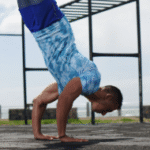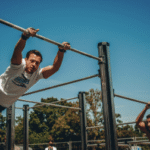Handstand Training: Improve Your Strength and Balance
Handstand training is a journey of physical and mental empowerment, where you learn to defy gravity, build incredible strength, and develop a deep connection with your body. Whether you’re a complete beginner or an experienced mover, dedicated handstand training can transform your fitness and unlock new levels of body control and awareness. Here’s a detailed guide to handstand training:
- Foundational Strength and Flexibility
Wrist Preparation: Strong and flexible wrists are crucial for handstands. Incorporate wrist warm-ups, stretches, and strengthening exercises like wrist curls and reverse wrist curls.
Shoulder Strength: Build shoulder strength with exercises like pike push-ups, incline push-ups, and wall walks. These movements prepare your shoulders for the demands of supporting your bodyweight in a handstand.
Core Strength: Develop core strength with planks, hollow body holds, and leg raises. A strong core is essential for maintaining a straight line and preventing back arching in a handstand.
Flexibility: Improve shoulder and hamstring flexibility with stretches like shoulder dislocations, pike stretches, and hamstring stretches. Flexibility allows for better alignment and reduces the risk of injuries.
- Handstand Progressions
Wall-Assisted Handstands: Start with wall-assisted handstands to get comfortable with the inverted position and build strength. Practice kicking up to the wall and holding the handstand with your chest facing the wall.
Wall Walks: Walk your feet up the wall while walking your hands closer to the wall until you reach a handstand position. This helps build shoulder and core strength while getting you used to being upside down.
Freestanding Handstand with a Spotter: Once you feel comfortable with wall-assisted handstands, practice freestanding handstands with a spotter to provide support and feedback.
Freestanding Handstand Holds: Gradually increase the duration of your freestanding handstand holds, focusing on maintaining a straight line and engaging your core.
- Technique and Alignment
Hand Placement: Place your hands shoulder-width apart with your fingers pointing forward. Spread your fingers wide and grip the floor firmly.
Shoulder Engagement: Push your shoulders towards your ears to create a stable base and prevent your shoulders from collapsing.
Core Activation: Engage your core muscles to maintain a straight line from your hands to your feet. This prevents your back from arching and helps you stay balanced.
Head Position: Keep your head neutral, looking straight ahead or slightly towards your hands. Avoid tucking your chin or looking up, which can throw off your balance.
- Drills and Exercises
Kick-Up Drills: Practice kick-ups to improve your handstand entry and balance. Focus on kicking up with control and bringing your legs together in a straight line.
Wall Drills: Use the wall to practice handstand holds, shoulder shrugs, and leg movements to improve your control and stability.
Freestanding Drills: Practice freestanding handstand holds, balancing on one arm, and handstand walking to further challenge your skills.
- Training Schedule and Recovery
Consistency: Train consistently, aiming for at least 3-4 handstand practice sessions per week.
Progressive Overload: Gradually increase the difficulty of your training by increasing hold times, attempting more challenging variations, or adding handstand push-ups.
Rest and Recovery: Allow adequate rest between training sessions to prevent overuse injuries and promote muscle recovery.
Listen to Your Body: Pay attention to any pain or discomfort and adjust your training accordingly.
- Mental Aspects
Overcoming Fear: Handstands can be intimidating, but overcoming fear is essential for progress. Start with safe progressions and gradually build your confidence.
Focus and Concentration: Handstands require focus and concentration to maintain balance and control. Practice mindfulness and visualization techniques to improve your mental game.
Patience and Perseverance: Mastering handstands takes time and effort. Be patient with your progress and don’t give up.
Finding Handstand Training in Belo Horizonte
Calisthenics Classes: Look for calisthenics classes or workshops that incorporate handstand training.
Some gymnastics gyms offer handstand classes or open gym time where you can practice.
Include handstands and inversions in their classes.
Often teach handstands as part of their curriculum.
Consider hiring a calisthenics coach or personal trainer for personalized handstand instruction.
Benefits of Handstand Training – Calisthenics Club Houston Functional Body weight Training
Increased Strength: Handstands build significant upper body and core strength.
Improved Balance: Handstand training enhances your balance and coordination.
Enhanced Flexibility: Stretching and mobility work involved in handstand training can improve your flexibility.
Mental Focus: Balancing on your hands requires focus and concentration, which can benefit your mental clarity and mindfulness.
Confidence Boost: Achieving a handstand can be a significant accomplishment, boosting your self-confidence and sense of empowerment.
Handstand training is a rewarding journey that challenges you both physically and mentally. By following these guidelines, finding the right training resources in Calisthenics Club Houston Functional Body weight Training, and embracing the process, you can improve your strength, balance, and body control, and eventually experience the thrill of mastering the handstand.

Handstand Training: Improve Your Strength and Balance
Route
Calisthenics Gym Houston Functional Bodyweight Training
Secondary phone: (346) 483-3195
Email: info@calisthenicsclubhouston.com
URL: https://calisthenicsclubhouston.com/
Monday 6:00 AM - 7:00 PM Tuesday 6:00 AM - 7:00 PM Wednesday 6:00 AM - 7:00 PM Thursday 6:00 AM - 7:00 PM Friday 12:00 PM - 6:30 PM Saturday 9:45 AM - 12:00 PM Sunday 3:00 PM - 5:00 PM





